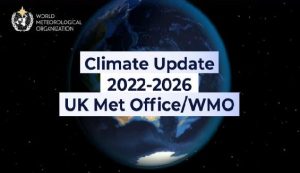19-05-2023
LONDON: In a historic development, global temperatures are now more likely than not to exceed 1.5 degrees Celsius (2.7 degrees Fahrenheit) of warming within the next five years, according to the World Meteorological Organization (WMO). This does not imply that the world will surpass the long-term warming threshold of 1.5C above preindustrial levels set by the 2015 Paris Agreement.
 However, experiencing a year of warming at 1.5C could provide a glimpse into what surpassing that long-term threshold, based on the 30-year global average, would entail. With a 66% probability of temporarily reaching 1.5C by 2027, Adam Scaife, head of long-range prediction at Britain’s Met Office Hadley Centre, who contributed to the WMO’s latest Global Annual to Decadal Climate Update, stated that “it’s the first time in history that it’s more likely than not that we will exceed 1.5C.” Last year’s report estimated the odds at roughly 50-50.
However, experiencing a year of warming at 1.5C could provide a glimpse into what surpassing that long-term threshold, based on the 30-year global average, would entail. With a 66% probability of temporarily reaching 1.5C by 2027, Adam Scaife, head of long-range prediction at Britain’s Met Office Hadley Centre, who contributed to the WMO’s latest Global Annual to Decadal Climate Update, stated that “it’s the first time in history that it’s more likely than not that we will exceed 1.5C.” Last year’s report estimated the odds at roughly 50-50.
Even reaching 1.5C temporarily indicates that as such occurrences become more frequent, we are approaching the actual long-term climate threshold. This also suggests that global progress in reducing climate-warming greenhouse gas emissions has been inadequate.
An El Niño weather pattern expected to develop in the upcoming months partially contributes to the increased likelihood of nearing 1.5C. During El Niño, warmer waters in the tropical Pacific elevate the atmospheric temperature, leading to global temperature rises.
WMO Secretary-General Petteri Taalas stated that El Niño “will combine with human-induced climate change to push global temperatures into uncharted territory.” The mid-year shift to El Niño is concerning scientists  worldwide. Although distinct from climate change, this weather phenomenon is likely to intensify extremes, resulting in warmer weather in North America, drought in South America, and an elevated risk of wildfires in the Amazon.
worldwide. Although distinct from climate change, this weather phenomenon is likely to intensify extremes, resulting in warmer weather in North America, drought in South America, and an elevated risk of wildfires in the Amazon.
The likelihood of temporarily exceeding 1.5C has progressively increased over time. For instance, scientists had previously estimated only a 10% chance of reaching 1.5C between 2017 and 2021.
Unlike the climate projections of the U.N. Intergovernmental Panel on Climate Change, which rely on future greenhouse gas emissions, the WMO update offers more of a prediction-based long-range weather forecast.
The WMO also determined a 98% probability that one of the next five years will be the hottest on record, surpassing 2016, which experienced a global temperature rise of approximately 1.3C (2.3F).
Doug Parr, chief scientist at Greenpeace UK, emphasized that “this report must be a rallying cry to intensify global efforts to tackle the climate crisis.” (Int’l News Desk)
 Pressmediaofindia
Pressmediaofindia




